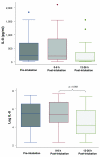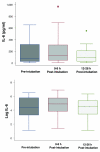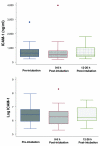Biological markers of lung injury before and after the institution of positive pressure ventilation in patients with acute lung injury
- PMID: 16956410
- PMCID: PMC1751077
- DOI: 10.1186/cc5037
Biological markers of lung injury before and after the institution of positive pressure ventilation in patients with acute lung injury
Abstract
Background: Several biological markers of lung injury are predictors of morbidity and mortality in patients with acute lung injury (ALI). The low tidal volume lung-protective ventilation strategy is associated with a significant decrease in plasma biomarker levels compared to the high tidal volume ventilation strategy. The primary objective of this study was to test whether the institution of lung-protective positive pressure ventilation in spontaneously ventilating patients with ALI exacerbates pre-existing lung injury by using measurements of biomarkers of lung injury before and after intubation.
Materials and methods: A prospective observational cohort study was conducted in the intensive care unit of a tertiary care university hospital. Twenty-five intubated, mechanically ventilated patients with ALI were enrolled. Physiologic data and serum samples were collected within 6 hours before intubation and at two different time points within the first 24 hours after intubation to measure the concentration of interleukin (IL)-6, IL-8, intercellular adhesion molecule 1 (ICAM-1), and von Willebrand factor (vWF). The differences in biomarker levels before and after intubation were analysed using repeated measures analysis of variance and a paired t test with correction for multiple comparisons.
Results: Before endotracheal intubation, all of the biological markers (IL-8, IL-6, ICAM-1, and vWF) were elevated in the spontaneously breathing patients with ALI. After intubation and the institution of positive pressure ventilation (tidal volume 7 to 8 ml/kg per ideal body weight), none of the biological markers was significantly increased at either an early (3 +/- 2 hours) or later (21 +/- 5 hours) time point. However, the levels of IL-8 were significantly decreased at the later time point (21 +/- 5 hours) after intubation. During the 24-hour period after intubation, the PaO2/FiO2 (partial pressure of arterial oxygen/fraction of the inspired oxygen) ratio significantly increased and the plateau airway pressure significantly decreased.
Conclusion: Levels of IL-8, IL-6, vWF, and ICAM-1 are elevated in spontaneously ventilating patients with ALI prior to endotracheal intubation. The institution of a lung-protective ventilation strategy with positive pressure ventilation does not further increase the levels of biological markers of lung injury. The results suggest that the institution of a lung-protective positive pressure ventilation strategy does not worsen the pre-existing lung injury in most patients with ALI.
Figures




Similar articles
-
High-frequency percussive ventilation and initial biomarker levels of lung injury in patients with minor burns after smoke inhalation injury.Burns. 2015 Feb;41(1):65-70. doi: 10.1016/j.burns.2014.05.007. Epub 2014 Jun 28. Burns. 2015. PMID: 24986596
-
Ventilation strategy using low tidal volumes, recruitment maneuvers, and high positive end-expiratory pressure for acute lung injury and acute respiratory distress syndrome: a randomized controlled trial.JAMA. 2008 Feb 13;299(6):637-45. doi: 10.1001/jama.299.6.637. JAMA. 2008. PMID: 18270352 Clinical Trial.
-
Neuromuscular blockade is associated with the attenuation of biomarkers of epithelial and endothelial injury in patients with moderate-to-severe acute respiratory distress syndrome.Crit Care. 2018 Mar 10;22(1):63. doi: 10.1186/s13054-018-1974-4. Crit Care. 2018. PMID: 29523157 Free PMC article.
-
von Willebrand factor antigen is an independent marker of poor outcome in patients with early acute lung injury.Crit Care Med. 2001 Dec;29(12):2325-31. doi: 10.1097/00003246-200112000-00016. Crit Care Med. 2001. PMID: 11801836 Review.
-
Pathogenetic significance of biological markers of ventilator-associated lung injury in experimental and clinical studies.Chest. 2006 Dec;130(6):1906-14. doi: 10.1378/chest.130.6.1906. Chest. 2006. PMID: 17167015 Free PMC article. Review.
Cited by
-
The Role of Von Willebrand Factor in the Pathogenesis of Pulmonary Vascular Thrombosis in COVID-19.Viruses. 2022 Jan 21;14(2):211. doi: 10.3390/v14020211. Viruses. 2022. PMID: 35215805 Free PMC article.
-
Tidal volume and plateau pressure use for acute lung injury from 2000 to present: a systematic literature review.Crit Care Med. 2014 Oct;42(10):2278-89. doi: 10.1097/CCM.0000000000000504. Crit Care Med. 2014. PMID: 25098333 Free PMC article.
-
Diagnosis and treatment of acute pulmonary inflammation in critically ill patients: The role of inflammatory biomarkers.World J Crit Care Med. 2019 Sep 11;8(5):59-71. doi: 10.5492/wjccm.v8.i5.59. eCollection 2019 Sep 11. World J Crit Care Med. 2019. PMID: 31559145 Free PMC article. Review.
-
Plasma Biomarker Analysis in Pediatric ARDS: Generating Future Framework from a Pilot Randomized Control Trial of Methylprednisolone: A Framework for Identifying Plasma Biomarkers Related to Clinical Outcomes in Pediatric ARDS.Front Pediatr. 2016 Mar 31;4:31. doi: 10.3389/fped.2016.00031. eCollection 2016. Front Pediatr. 2016. PMID: 27066464 Free PMC article.
-
Sphingosine-1-phosphate receptor-3 is a novel biomarker in acute lung injury.Am J Respir Cell Mol Biol. 2012 Nov;47(5):628-36. doi: 10.1165/rcmb.2012-0048OC. Epub 2012 Jul 5. Am J Respir Cell Mol Biol. 2012. PMID: 22771388 Free PMC article.
References
-
- Brun-Buisson C, Minelli C, Bertolini G, Brazzi L, Pimentel J, Lewandowski K, Bion J, Romand JA, Villar J, Thorsteinsson A, et al. Epidemiology and outcome of acute lung injury in European intensive care units. Results from the ALIVE study. Intensive Care Med. 2004;30:51–61. doi: 10.1007/s00134-003-2022-6. - DOI - PubMed
-
- Amato MB, Barbas CS, Medeiros DM, Magaldi RB, Schettino GP, Lorenzi-Filho G, Kairalla RA, Deheinzelin D, Munoz C, Oliveira R, et al. Effect of a protective-ventilation strategy on mortality in the acute respiratory distress syndrome. N Engl J Med. 1998;338:347–354. doi: 10.1056/NEJM199802053380602. - DOI - PubMed
-
- Hickling KG, Walsh J, Henderson S, Jackson R. Low mortality rate in adult respiratory distress syndrome using low-volume, pressure-limited ventilation with permissive hypercapnia: a prospective study. Crit Care Med. 1994;22:1568–1578. - PubMed
Publication types
MeSH terms
Substances
Grants and funding
LinkOut - more resources
Full Text Sources
Other Literature Sources
Miscellaneous

